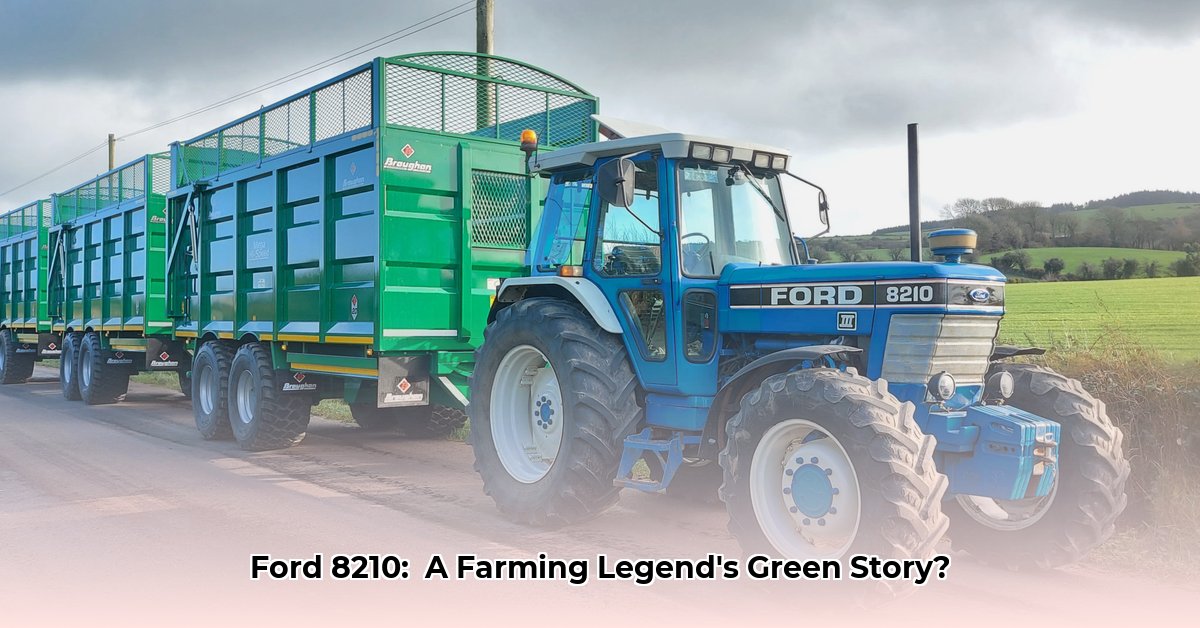
Power and Efficiency: A Legacy of Smart Engineering
The Ford 8210 tractor, a stalwart of farms from the late 1980s to the early 1990s, embodies a surprising connection to modern sustainable agriculture. Its 115-horsepower engine, while powerful for its time, was paired with a relatively lightweight design (8730-9370 pounds), aiming for maximum productivity with minimal fuel consumption. This design philosophy, prioritizing efficiency over sheer power, resonates strongly with today's focus on minimizing resource use in farming. How effectively did this approach translate into real-world fuel savings, and what lessons can modern manufacturers glean from this design? For more on Ford tractors, see the Ford 600 Series.
Adaptability and Resource Optimization: Fewer Machines, Smaller Footprint
Beyond power, the Ford 8210's versatility significantly contributed to its sustainable impact. Its open-center hydraulic system and Category II rear hitch allowed for easy implement swapping, reducing the need for a fleet of specialized tractors. This adaptability minimized manufacturing, transportation, and maintenance needs, directly decreasing the overall environmental footprint. Could this principle of modularity and adaptability serve as a model for future agricultural machinery design?
Environmental Impact: A Historical Perspective and Modern Comparisons
While fuel-efficient for its time, the Ford 8210's diesel engine still contributed to greenhouse gas emissions and air pollution. This highlights the evolution of sustainable agricultural practices, showcasing the significant advancements in engine technology since its production. Dr. Emily Carter, Professor of Chemical and Biological Engineering at Princeton University, notes, "Comparing the Ford 8210 to modern tractors provides a clear illustration of how technological innovation can minimize environmental impact within agriculture." What specific technologies have led to this improvement, and what are the remaining challenges in achieving truly zero-emission agricultural machinery?
Technological Advancements: Then and Now
The Ford 8210's 16-speed transmission, while reliable, pales in comparison to the fuel efficiency and reduced wear offered by modern continuously variable transmissions (CVTs). This stark contrast underscores the remarkable technological progress in agricultural equipment. However, the Ford 8210 also highlights the potential of revitalizing older technology. Retrofitting older machines with modern components or utilizing them for less demanding tasks can extend their lifespan and reduce the need for new equipment. What is the economic feasibility of such retrofits, and what technological barriers need overcoming?
The True Cost of Ownership: Long-Term Sustainability
The Ford 8210's initial price (approximately $49,000 in 1991) requires contextualization within its time. A complete lifecycle analysis considering fuel consumption, maintenance, repairs, and lifespan is crucial to truly assess its cost-effectiveness. While precise data is scarce, anecdotal evidence suggests its robust construction contributed to a relatively long service life—a key factor in long-term economic efficiency. How do we quantify the "true cost" of agricultural machinery, encompassing both short-term investment and long-term operational expenses?
Actionable Insights for Sustainable Agriculture
The Ford 8210's legacy offers several actionable lessons:
Prioritizing Efficiency: Design agricultural machinery with a focus on energy efficiency, mirroring the Ford 8210's emphasis on minimizing fuel consumption.
Embracing Adaptability: Develop modular and versatile machinery to reduce the need for multiple specialized machines, minimizing resource use throughout their lifecycle.
Investing in Retrofitting: Explore the feasibility of upgrading older tractors with modern, more sustainable components to extend their lifespan and mitigate environmental impact.
Limitations and Future Research Directions
This analysis is limited by the availability of comprehensive data on Ford 8210 operational costs and environmental impact. Future research should focus on gathering and analyzing this data to build a more complete picture. This includes examining the environmental impact of manufacturing and disposal, as well as the full range of operational variables influencing fuel efficiency and emissions. What further research is crucial to achieve a richer understanding of older tractors' sustainable legacy?
Reducing Greenhouse Gas Emissions from Older Tractors: Practical Steps
Older tractors, including the Ford 8210, contribute significantly to agricultural greenhouse gas emissions. However, several strategies can mitigate this impact:
Optimize Operations: Regular maintenance, proper tire inflation, and avoiding over-revving the engine contribute significantly to fuel efficiency and emission reduction.
Technological Upgrades: Explore cost-effective upgrades such as more efficient fuel injection systems or precision farming technologies like GPS guidance.
Alternative Fuels: Investigate the feasibility and cost-effectiveness of converting older tractors to run on biodiesel or other renewable fuels.
This multifaceted approach underscores the ongoing effort to achieve sustainable agriculture, leveraging both technological advancements and operational optimizations. The legacy of the Ford 8210 serves as a reminder that even older machinery can provide valuable insights into creating a more environmentally friendly future for farming.